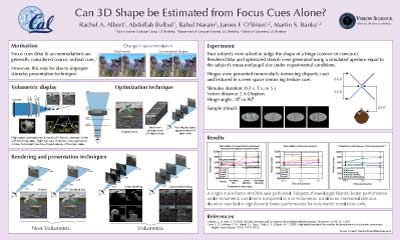Can 3D Shape be Estimated from Focus Cues Alone?

Download Paper
Download Bibtex
Authors
- Rachel A. Albert
- Abdullah Bulbul
- Rahul Narain
- James F. O'Brien
- Martin S. Banks
Abstract
Focus cues—blur and accommodation—have generally been regarded as very coarse, ordinal cues to depth. This assessment has been largely determined by the inability to display these cues correctly with conventional displays. For example, when a 3D shape is displayed with sharp rendering (i.e., pinhole camera), the expected blur variation is not present and accommodation does not have an appropriate effect on the retinal image. When a 3D shape with rendered blur (i.e., camera with non-pinhole aperture) is displayed, the viewer's accommodation does not have the appropriate retinal effect. We asked whether the information provided by correct blur and accommodation can be used to determine shape. We conducted a shape-discrimination experiment in which subjects indicated whether a hinge stimulus was concave or convex. The stimuli were presented monocularly in a unique volumetric display that allows us to present correct or nearly correct focus cues. The hinge was textured using a back-projection technique, so the stimuli contained no useful shape cues except blur and accommodation. We used four rendering methods that vary in the validity of focus information. Two single-plane methods mimicked a conventional display and two volumetric methods mimicked natural viewing. A pinhole camera model was used in one single-plane condition, so image sharpness was independent of depth. In the other single-plane condition, natural blur was rendered thereby creating an appropriate blur gradient. In one volumetric condition, a linear blending rule was used to assign intensity to image planes. In the other volumetric condition, an optimized blending rule was used that creates a closer approximation to real-world viewing. Subject performance was at chance in the single-plane conditions. Performance improved substantially when in the volumetric conditions, slightly better in the optimized-blending condition. This is direct evidence that 3D shape judgments can be made from the information contained in blur and accommodation alone.
Citation
Rachel A. Albert, Abdullah Bulbul, Rahul Narain, James F. O'Brien, , and Martin S. Banks. "Can 3D Shape be Estimated from Focus Cues Alone?". Journal of Vision, 14(10):732, August 2014.
Supplemental Material









